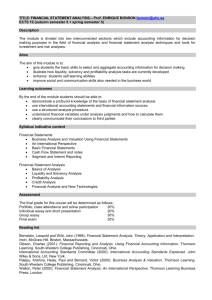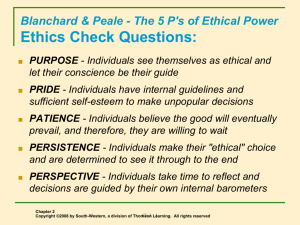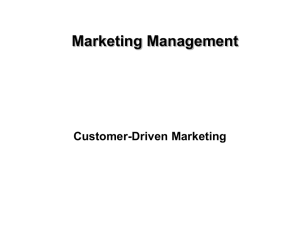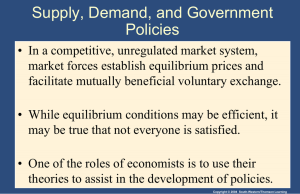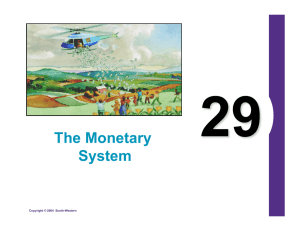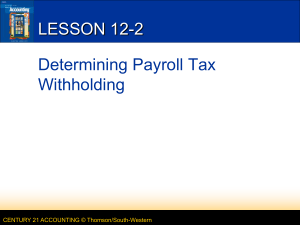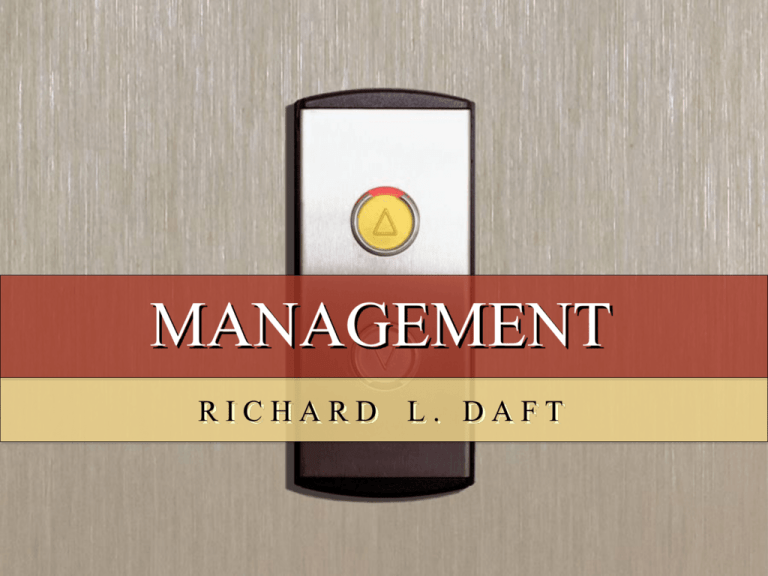
MANAGEMENT
RICHARD
L. DAFT
Managing in Turbulent Times
CHAPTER 1
Learning Objectives
3
Describe the four management functions and the type of
management activity associated with each.
Explain the difference between efficiency and
effectiveness and their importance for organizational
performance.
Describe management types and the horizontal and
vertical differences between them.
Describe conceptual, human, and technical skills and
their relevance for managers and employees.
Define 10 roles that managers perform in organization.
Copyright © 2008 by South-Western, a division of Thomson Learning. All rights reserved.
Learning Objectives (contd.)
4
Understand the personal challenges involved in
becoming a new manager in an organization in today’s
world.
Discuss the management competencies needed to deal
with today’s turbulent environment, including issues such
as diversity, globalization, and rapid changes.
Explain the leadership skills needed for effective crisis
management.
Copyright © 2008 by South-Western, a division of Thomson Learning. All rights reserved.
The Nature of Management
1.
2.
3.
5
Managers have to cope with diverse
and far-reaching challenges
To keep pace with ever-advancing
technology
To find ways to incorporate the Internet
and e-business into their strategies and
business model
Strive to remain competitive in a
dynamic and far reaching world
Copyright © 2008 by South-Western, a division of Thomson Learning. All rights reserved.
What Do Managers Have in Common?
6
They get things done through their
organization.
They create the systems, conditions and
environment that enable organizations to
survive and thrive beyond the tenure of
any specific supervisor or manager.
Copyright © 2008 by South-Western, a division of Thomson Learning. All rights reserved.
Definition of Management
The attainment of organizational goals in
an effective and efficient manner through
Four functions
–
–
–
–
planning,
organizing,
leading, and
controlling organizational resources.
Managers use a multitude of skills to
perform functions
7
Copyright © 2008 by South-Western, a division of Thomson Learning. All rights reserved.
Functions of Management
Planning
Select goals and
ways to attain
them
Organizing
Controlling
Monitor activities and
make corrections
Assign responsibility
for task
accomplishment
Leading
Use influence to
motivate employees
8
Copyright © 2008 by South-Western, a division of Thomson Learning. All rights reserved.
The Process of Management
Planning
Select goals and
ways to attain
them
Performance
Resources
•Human
•Financial
•Raw Materials
•Technological
•Attain goals
Organizing
Controlling
Monitor activities
and make
corrections
Assign responsibility
for task
accomplishment
•Information
•Products
•Services
•Efficiency
•Effectiveness
Leading
Use influence to
motivate employees
Exhibit 1.1
9
Copyright © 2008 by South-Western, a division of Thomson Learning. All rights reserved.
Planning Function
Definition
–
–
Corporate Examples
–
–
10
Defines goals for future organizational
performance
Decides tasks and use of resources needed
Planning – AOL Time Warner – The Lord of
the Rings
Lack of planning – Merry-Go-Round
Copyright © 2008 by South-Western, a division of Thomson Learning. All rights reserved.
Organizing Function
Definition
–
–
–
Follows planning
Reflects how organization tries to accomplish
plan
Involves assignment of
Corporate Examples - Structural
reorganizations
–
11
tasks into departments
authority and allocation of resources across
organization
IBM, the Catholic Church, Microsoft, Motorola,
the FBI
Copyright © 2008 by South-Western, a division of Thomson Learning. All rights reserved.
Leading Function
12
Definition
– The use of influence to motivate
employees to achieve the organization’s
goals.
Corporate Examples – Michael Dell, Meg
Whitman of eBay, Cara Kakuda of Nextel
Copyright © 2008 by South-Western, a division of Thomson Learning. All rights reserved.
Controlling Function
Definition
13
●
Monitoring employees’ activities
●
Determining whether the
organization is on target toward its
goals
●
Making corrections as necessary
Copyright © 2008 by South-Western, a division of Thomson Learning. All rights reserved.
Controlling Function
New Trends
14
Empowerment and trust of employees =
training employees to monitor and correct
themselves
New information technology provides control
without strict top-down constraints
Lack of Control Information can lead to
Organizational Failure
Copyright © 2008 by South-Western, a division of Thomson Learning. All rights reserved.
Organizational Performance
Attainment of organizational
goals in an efficient and
effective manner
The Process of Management
15
Copyright © 2008 by South-Western, a division of Thomson Learning. All rights reserved.
2nd half of
definition of
management
Organizational Performance
16
Organization - social entity that is goal directed and
deliberately structured
Effectiveness - degree to which organization achieves a
stated goal
Efficiency - use of minimal resources (raw materials,
money, and people) to produce the desired volume of
output
Performance – organization’s ability to attain its goals by
using resources in an efficient and effective manner
Copyright © 2008 by South-Western, a division of Thomson Learning. All rights reserved.
Management Skills
Exhibit 1.2
17
Copyright © 2008 by South-Western, a division of Thomson Learning. All rights reserved.
Management Skills
Conceptual Skills – Cognitive ability to see the
organization as a whole and the relationships among
its parts
Human Skills – ability to work with and through
other people and to work effectively as a group
member
Technical Skills – understanding of and
proficiency in the performance of specific tasks
When skills Fail
Experiential Exercise: Management Aptitude Questionnaire
18
Copyright © 2008 by South-Western, a division of Thomson Learning. All rights reserved.
Management Types - Vertical
Managerial Levels in the Organizational Hierarchy
Managerial Levels in the Organizational Hierarchy
Exhibit 1.3
19
Copyright © 2008 by South-Western, a division of Thomson Learning. All rights reserved.
Management Types - Horizontal
Functional Managers
–
–
General Managers
–
20
Responsible for a department that performs
a single functional task and
Has employees with similar training and
skills
Responsible for several departments that
perform different functions
Copyright © 2008 by South-Western, a division of Thomson Learning. All rights reserved.
Managerial Types - Horizontal
Functional Managers
–
–
–
–
–
–
21
Advertising
Sales
Finance
Human Resources
Manufacturing
Accounting
General Managers
–
Self-contained division
such as a Macy’s
department store
–
Project managers have
general management
responsibility as they
coordinate people across
several departments
Copyright © 2008 by South-Western, a division of Thomson Learning. All rights reserved.
What is it like to be a Manager?
Manager Activities
–
Multitasking
–
Life on Speed Dial
Manager’s Role
–
–
22
Fragmentation, Variety, Brevity
Set of expectations for one’s behavior
Diverse activities --10 roles
Copyright © 2008 by South-Western, a division of Thomson Learning. All rights reserved.
Making the Leap From Individual Performer to
Manager
Exhibit 1.4
23
Copyright © 2008 by South-Western, a division of Thomson Learning. All rights reserved.
Ten Manager Roles
Category
Role
Informational
Monitor
Disseminator
Spokesperson
Interpersonal
Figurehead
Leader
Liaison
Decisional
Entrepreneur
Disturbance handler
Resource allocator
negotiator
24
Copyright © 2008 by South-Western, a division of Thomson Learning. All rights reserved.
Hierarchical Levels
Exhibit 1.6
25
Copyright © 2008 by South-Western, a division of Thomson Learning. All rights reserved.
Managing in Small Businesses and Nonprofit
Organizations
26
Role Differences
Source of Financial Resources
Unconventional Bottomline
Copyright © 2008 by South-Western, a division of Thomson Learning. All rights reserved.
Management and the New Workplace
Exhibit 1.7
27
Copyright © 2008 by South-Western, a division of Thomson Learning. All rights reserved.
Management and the New Workplace
Forces on organizations
New Management Competencies
–
–
–
–
–
28
Dispersed leadership
Empowering others
Collaborative relationships
Team-building skills
Learning organization
Copyright © 2008 by South-Western, a division of Thomson Learning. All rights reserved.
Managing During Turbulent Times
29
Stay Calm
Be Visible
Put People Before Business
Tell the Truth
Know When to Get Back to Business
Copyright © 2008 by South-Western, a division of Thomson Learning. All rights reserved.

